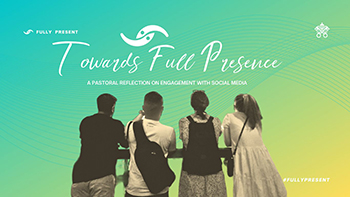If you’ve spent a significant amount of time today scrolling through Facebook, browsing TikTok or reading snippets of online news and gossip, take a moment to pause in silence and reflect upon your use of digital media. Then go and read the Vatican’s document, Towards Full Presence: A Pastoral Reflection on Engagement with Social Media. It’s well worth it.
 Although it was published in May 2023, it’s taken me almost six months to pause my rapid scrolling, notification checking and information scanning to read the document in full. In doing so, I discovered the reason for this delay: like others, I’ve faced information overload and developed an insatiable thirst for fast, continuous, new digital content, resulting in a loss of cognitive capacity to read something longer than 200 characters.
Although it was published in May 2023, it’s taken me almost six months to pause my rapid scrolling, notification checking and information scanning to read the document in full. In doing so, I discovered the reason for this delay: like others, I’ve faced information overload and developed an insatiable thirst for fast, continuous, new digital content, resulting in a loss of cognitive capacity to read something longer than 200 characters.
In a nutshell, that’s what the document is all about. It seeks to inspire the reader to stop buying into the digital world’s push for more and more content, and to make time to reflect and discern deeper questions about his/her use of social media, in particular.
The document is no novel – it’s a little over 11,000 words and roughly 20 pages of text – but if you’re a digital native with a reduced attention span, you’ll still need a firm push to motivate you to read it.
Eventually, it took about two hours to read through the document slowly and take notes. The process of reading the document felt somewhat prayerful; and in doing so I was taking the first, small steps to meet the challenge it presents: to take a break from the chaos of the digital world and to develop a contemplative spirit which should influence our digital interactions.
 A key theme of the document, published by the Vatican’s Dicastery for Communication, revolves around Christian charity for one’s neighbour, with frequent reference made to the parable of the Good Samaritan (Luke 10). In the same way that the Samaritan resists the temptation to simply pass by the wounded man, social media users should work to create meaningful encounters with others online, rather than merely scrolling past.
A key theme of the document, published by the Vatican’s Dicastery for Communication, revolves around Christian charity for one’s neighbour, with frequent reference made to the parable of the Good Samaritan (Luke 10). In the same way that the Samaritan resists the temptation to simply pass by the wounded man, social media users should work to create meaningful encounters with others online, rather than merely scrolling past.
From an encounter can come a relationship, which in turn can help form community, and so through each user’s imitation of the Good Samaritan, we can contribute to redeeming the digital world, helping it to rediscover its potential for community-building.
The document begins by briefly exploring the nature of digital communication, the impact it has had on the world and its capacity for good. In the first section, readers are alerted to some of the “pitfalls on the digital highways”, such as the commercialisation of the internet and the “digital divide” that leaves those without access to digital technology “stranded on the roadside”. Although many had high hopes for the internet as a “type of promised land” three decades ago, social media “platforms that promise to build community and bring the world closer together have instead deepened various forms of division”.
This is where the Good Samaritan – or every Christian – comes in.
 Instead of passing by those who are wounded by division on the digital highways, the Christian is called to make the first move towards overcoming indifference; to move purposefully towards a genuine encounter of friendship and peace.
Instead of passing by those who are wounded by division on the digital highways, the Christian is called to make the first move towards overcoming indifference; to move purposefully towards a genuine encounter of friendship and peace.
That’s the first step in the process: to work towards building a “culture of encounter” online.
The second section of the document reflects on how an initial encounter can develop into something more authentic and meaningful, in the same way that the interaction between two complete strangers in the parable does. This starts with silence and listening.
At this point, the change in the user’s behaviour needs to extend beyond the swiping index finger.
The user’s own relationship with God needs to be strengthened, through prayer and contemplation. By nurturing our own spiritual life, we grow in the ability to listen well.
This interior habit of prayerful discernment and deep reflection, when applied to our communications on social media, opens the door to a meaningful encounter with our digital neighbour. In doing so, we move from having simply “connections” on social media to “relationships”.
In the third part of the document, titled ‘From Encounter to Community’, we begin to reflect upon the need to take concrete actions, to work towards building community. In a spirit of fraternal charity, we can create online communities that strive to reach out to support those in need. Better still, we can use social media to build genuine, physical communities that will imitate the Good Samaritan.
The final section of the document seeks to provide some advice on how we should engage with social media, by referring to God’s style of communicating – characterised by “closeness, compassion and tenderness”. The way in which we say something online is equally as important as what we say. We should seek to communicate truth, goodness and beauty, in a reflective, rather than reactive, style.
The document encourages Christians to regard their social media presence as an opportunity to be witnesses, and even missionaries, in the digital world. Every Christian has the potential to influence others online by how they communicate. Instead of criticising, fault-finding or accusing, “we are called to show another way”.
Our social media presence should be “known for our availability to listen, to discern before acting, to treat all people with respect, to respond with a question rather than a judgment, to remain silent rather than trigger a controversy”. By cultivating such a presence, we can open pathways for others to encounter Christ and His Church.
Links
Towards Full Presence: A Pastoral Reflection on Engagement with Social Media
Fully Present (website of the statement with related news, information and resources)
Images: Dicastery for Communication; The Good Samaritan by Luigi Sciallero (public domain); Unsplash.
Words: Matthew Biddle



